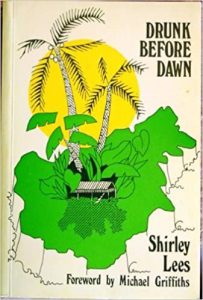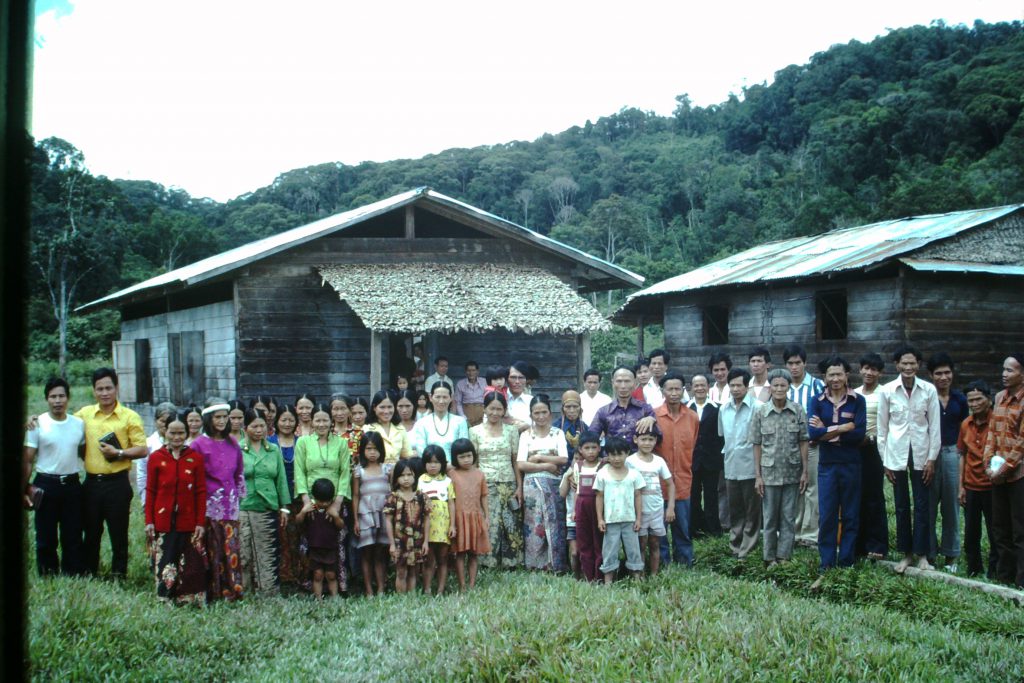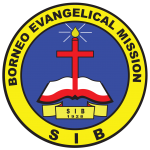The Borneo Evangelical Mission was formed in 1928 by students and staff at the Melbourne Bible Institute who were concerned for the evangelisation and the establishment of a church of the people of Borneo. Beginning in the state of Sarawak, the work of the Mission began slowly, but accelerated when first one then a number of people groups almost wholly turned to Christianity. Although briefly interrupted by the Second World War, the BEM was able to support and nourish what they saw as a work of God amongst these people groups, principally through Bible teaching and translation, and the training of local church leaders. By 1960, the various tribal churches had joined together in a fellowship called Sidang Injil Borneo (Evangelical Church of Borneo). The BEM continued in a role of providing assistance to this self-administered church and training Borneans who would render the Mission redundant. By the late 1980s the Mission had largely completed its role in Borneo and today the SIB stands alone as the biggest Protestant church in the modern state of Malaysia.
The BEM can be classified as a post-classical inter-denominational faith mission in the mould of the China Inland Mission. Its main aim reflects the three-self indigenisation formula common to many missions of the period. The major motive of saving the lost is also a common theme. The basic method of the Mission was to live simply amongst the various people groups and be prepared to co-operate with what they saw as God’s work of building his church. The Mission instituted a fifteen year policy for the completion of its contribution to this work in each group. Some particular features of the emergence of the indigenous church arise from the unusual political climate, the conversion dynamics of communitarian and animistic peoples, the occurrence of spontaneous people movements, and the social and theological expectations of the missionaries.
Parts 1 &2. A brief history of the Mission
1. Introduction
In 1927 students at the Melbourne Bible Institute (MBI) began to pray together for the missionary needs of Borneo and to seek out as much information about the island as they could. The following year, three of the praying students felt confirmed in moving towards mission in Borneo, and, with the support and guidance of their principal C.H. Nash and the MBI Executive Committee, the vision was refined and propagated throughout evangelical churches. The Borneo Evangelical Mission was formed on 31 August 1928, and in October the three now former students – Hudson Southwell, Frank Davidson, and Carey Tolley – were commissioned before sailing for the new mission field.
BEM as a mission society no longer exists and its many missionaries have come and gone, but the original vision for the establishment of a Bornean church has been fulfilled. The Sidang Injil Borneo (Evangelical Church of Borneo) is the largest Protestant church in Malaysia, with over 500 congregations and 500,000 members. The story of the BEM is a part of the heritage of the Melbourne School of Theology (successor to MBI) and it can be a source of inspiration and valuable lessons about mission. The purpose of this article is to outline the history of the Mission, discover its aims, motives and guiding principles of action, and to reflect on some aspects of the engagement with the Bornean context.
2. A brief history of the Mission
When BEM began, two-thirds of Borneo, the world’s third largest island, was under Dutch control, while the remainder consisted of the British Protectorates of North Borneo (Sabah), Sarawak (an independent state under the rule of the English Rajah Brooke), and the tiny sultanate of Brunei. It was for “the evangelisation of the untouched tribes of Central Borneo” that the founders of the BEM became particularly burdened (Lees, Drunk before dawn, 28). These “tribes” of various language groups were animists and mostly subsistence farmers, hunters and longhouse dwellers who organised themselves under village headmen and elders.
Life in a Longhouse
For descriptions of the different people groups from a secular point of view see, for instance Jørgen Bisch, Ulu: the world’s end. Translated by Reginald Spink. (London: George Allen & Unwin, 1961), and Hedda Morrison, Life in a longhouse (Borneo Literature Bureau, 1962) and Sarawak (London: Macgibbon & Kee, 1957) Insights into typical life in the longhouses from a Christian perspective can be found in the true-to-life stories told by Jenny Bray, Longhouse of fear (West Heidelberg: Victor, 1969) and Ken Nightingale, One way through the jungle (London: OMF Books, 1975).
2.1 The work up until the end of the Second World War
After they arrived in Borneo, the first missionaries were given permission to enter the Limbang River area of northern Sarawak, and there they set up their bases and commenced work amongst the Iban and Bisaya peoples. Over the following 10 years new missionaries came and the work of the Mission extended further inland and into Brunei. Davidson and his new wife had moved into the remote highlands of the Kelabit people. Southwell made a survey into the interior of North Borneo and later worked there with the Dusun people. These pioneering years were not easy and, although the missionaries were generally well-received, they saw very little response to the gospel.
How hardly…!
The Iban were the legendary “wild men of Borneo” having gained a reputation as “fighting men, head hunters and pirates”. By this time the White Rajah had stamped out such activities, but had not attempted any other developments amongst the Iban (Morrison, Life in a longhouse, 7, 9). The missionaries found the Iban to be quite hospitable but fiercely proud, self-sufficient, and more interested in spirit feasts and wealth than their message. The story of this first decade of Southwell’s virtually fruitless pioneering efforts among the Iban of Limbang (“the darker side of missionary work”) is candidly told in R. A. Bewsher, How hardly…!: a decade of missionary effort among the Dayaks (Jesselton, North Borneo: Borneo Evangelical Mission, 1939).
The BEM missionaries did not know then that another people, “the most degraded tribe in Borneo”, would become the key to the emergence of the church in Borneo, and that the movement of this tribe to Christianity was taking place without their help. The Lun Bawang people (formerly known as Muruts) were considered to be a dying race – ruined by chronic drunkenness and its devastating impact on their health, agricultural production and social life. It was reported that the average Lun Bawang man was drunk for 100 days out of each year! Although the missionaries had had some promising contacts with the Lun Bawang since the earliest days, they were prevented from establishing a presence in the Lun Bawang heartland of the upper Trusan until 1938. The White Rajah had asked the missionaries, “Why do you want to go to the Muruts? They are a worthless people; they are dying out?” (BEM, Native Borneo, 10).
Meanwhile, the Christian message came to the Trusan from across the border in Dutch East Borneo, where the Christian and Missionary Alliance (CMA) had been working since 1929. The CMA missionaries had seen the gospel spread through all the Lun Bawang of their side of the border, and it was some of these converts who took the message to their Sarawak kinsfolk and saw them also turn to Christianity en masse.
A Western non-missionary view: The Lun Bawang “grasped at the Christian faith like a drowning man clutching at a straw.” Morrison, Sarawak, 261.
 Consequently, when the BEM missionaries revisited the Trusan valley in 1938, they were astonished to find a tribe that had already been transformed – in longhouse after longhouse drunken feasting and other destructive practices had been replaced by prayer and hymn singing. People were eager to be taught more of the Christian gospel and its implications for every area of life. The opportunity and the need for nurture were so great that missionaries had to be moved from other people groups to live in the Trusan.
Consequently, when the BEM missionaries revisited the Trusan valley in 1938, they were astonished to find a tribe that had already been transformed – in longhouse after longhouse drunken feasting and other destructive practices had been replaced by prayer and hymn singing. People were eager to be taught more of the Christian gospel and its implications for every area of life. The opportunity and the need for nurture were so great that missionaries had to be moved from other people groups to live in the Trusan.
When the Pacific war broke out, the BEM missionaries, whose numbers had grown to seven, decided to stay in place for as long as possible. Soon after the Japanese occupation of Sarawak in 1941 they were either captured or forced to give themselves up for internment in Kuching. But some of them had managed to hide in the interior long enough to prepare the fledgling Lun Bawang church as best they could by teaching, baptising, translating portions of scripture and appointing elders and deacons. These efforts would be rewarded. When the missionaries returned after the war they found that not only had the Lun Bawang church held firm, its witness had led to the nominal conversion of almost the entire neighbouring Kelabit tribe.
2.3 After the war
So it was that the BEM had lost most of its material resources and some of its personnel due to the war (most notably, Davidson had died in internment in 1944), but was faced with greater opportunities than ever before. In 1947 Southwell baptised the first Kelabit Christians, and the following year saw many of the Dusun of Sabah being baptised and prepared for leadership.
 The highly cultured Kayan and Kenyah of the upper Baram and Rejang rivers, having heard reports of the incredible change in the formerly despised Lun Bawang, were now inviting the missionaries to come and teach them. As this gospel spread from village to village in each tribe and local Christian communities emerged, the missionaries scrambled to meet the needs for discipling, Bible teaching and translation, and training of pastors and deacons.
The highly cultured Kayan and Kenyah of the upper Baram and Rejang rivers, having heard reports of the incredible change in the formerly despised Lun Bawang, were now inviting the missionaries to come and teach them. As this gospel spread from village to village in each tribe and local Christian communities emerged, the missionaries scrambled to meet the needs for discipling, Bible teaching and translation, and training of pastors and deacons.
The Mission also began to redevelop its long-term resources and strategies for meeting these needs. In 1947 a new mission headquarters and a central Bible School were opened in Lawas in the lower Trusan area. Communications and travel were greatly improved with the pioneering of a small aviation service into the interior. Committing itself to the ideal of planned withdrawal, the BEM adopted a policy that allowed fifteen years for the establishment of the church amongst each people group entered. By the late fifties, the tribal churches had organised into a fellowship known as Sidang Injil Borneo (Evangelical Church of Borneo), and had appointed an Executive Council and adopted their own constitution. A 1960 conference brought together representatives of ninety churches from throughout Sarawak and Sabah. Conscious of the need to allow an independent leadership to develop, the Mission went through the process of separating its headquarters from the SIB’s central office and concentrated on working alongside the self-administered Church through the provision of its personnel, expertise, and infrastructure resources.
2.4 Mission in a developing, independent nation
The BEM was also coming to terms with the development and transition to nationhood of the land in which it worked, as Sarawak and Sabah joined with other states in founding the independent Federation of Malaysia. The movement of younger people to the coastal towns for employment and education necessitated the establishment of an urban ministry. During the 1970s three more Bible Schools were opened, and a radio and recording studio ministry was set up in co-operation with Far Eastern Broadcasting Company. Although the makeup of BEM personnel was always largely Australian, a number of Britons and New Zealanders also served with the Mission. The number of missionaries, which had peaked at sixty during the 50s and 60s, began to reduce quite sharply under the restrictive policies of the Malaysian government. Foreigners were granted visas only to carry out work that no Malaysian could do and then only for a maximum of ten years. Mission and Church therefore worked together to identify and prepare a national worker who would eventually take over the role of each missionary. Some went overseas for further Bible training. This came to fruition as Borneans progressively filled positions such as Bible School teachers and Advisers as they were vacated by missionaries.
In another strategic development, the BEM in 1975 became affiliated with the Overseas Missionary Fellowship to expand its resources and to provide opportunities for BEM missionaries to continue in other Asian fields. This was a somewhat natural partnership given the BEM’s strong affinities with the China Inland Mission (OMF’s forerunner) from its inception. It has now been several decades since the last full-time Field Leader left Borneo and by the late 1990s only two OMF couples remained in Sarawak, both in Bible teaching roles. However, close bonds of fellowship remained between the people of SIB and former missionaries, some of whom would return periodically to Sarawak to offer assistance and encouragement to the Church as appropriate.


BEM as a mission society no longer exists and its many missionaries have come and gone,…
BEM [Borneo Evangelical Mission] does exist.
Borneo Evangelical Mission (BEM) – A Protestant, evangelical Christian missionary society that was set up in 1928 to do gospel work amongst the people of Borneo.
Sidang Injil Borneo (SIB) – the Christian denomination (registered with the government as ROS [registral of Society] set up by BEM in the 1950s, as part of BEM’s objective to plant an “indigenous” church.
In the 2010s, SIB churches in Sarawak were legally “rebranded” as BEM churches. Reversing back using BEM under MSO [Missionary Society Ordinance]
Thank you Pastor Ting, that is a very interesting development in the 2010s. Could you outline the reasons for the reversion to BEM?